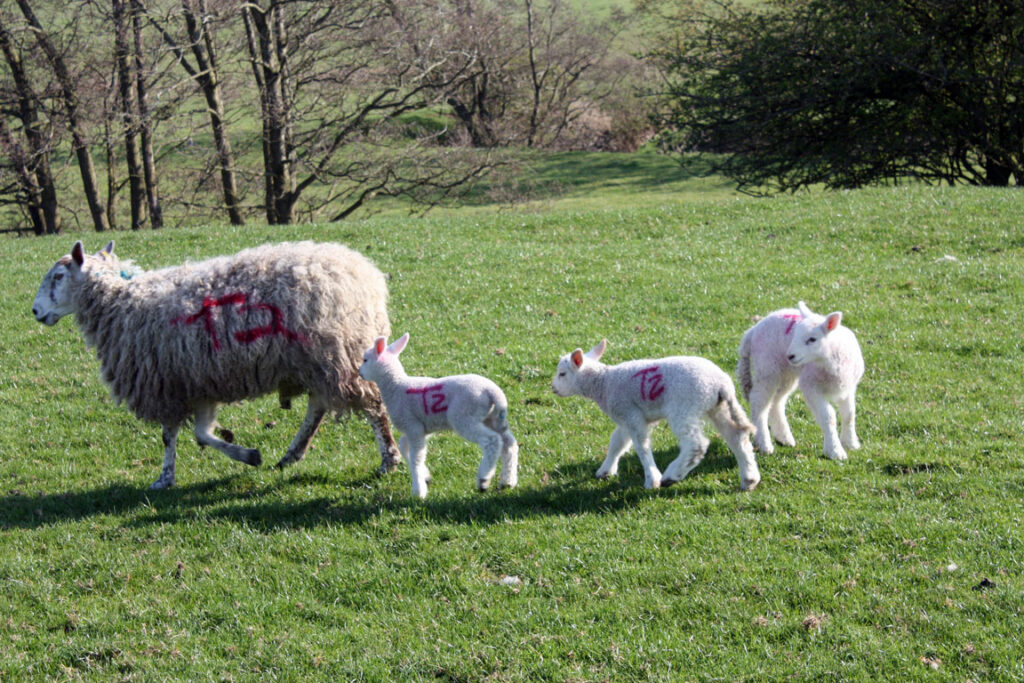Contents
- The objectives of the sheep enterprise
- The concepts of sheep nutrition
- Feed intake
- Energy
- Protein
- Minerals & Vitamins
- Water
- Popular husbandry systems
Protein Definitions
Crude Protein (CP)
This is the basic protein content of a feed; it is calculated by determining the nitrogen content of a feed.
It is not really a very true definition of the real protein content of that feed because it inevitably includes a proportion on Non-Protein-Nitrogen (NPN). It also assumes that the protein all contains 16% nitrogen. Therefore CP = Nitrogen content divided by 0.16 (or multiplied by 6.25).
Digestible Crude Protein (DCP)
Crude protein was never going to be a very reliable measurement of useful dietary protein. In some feed with low “Q” values, the digestibility of the protein was poor. In order to improve the reliability of dietary predictions the CP was multiplied by the “D” value to give the DCP.
Rumen Degradable Protein (RDP) / Undegradable Protein (UDP)
Unfortunately,the DCP measurement included a significant rogue element, NPN! NPN can be used very inefficiently in the rumen compared to true proteins. Rumen ammonia which is a form of NPN can give rise to high blood and milk urea’s if not managed properly.
In the 1970’s research suggested that dietary protein was, either broken down into ammonia (NH3) and carbon fragments in the rumen, and then used by the rumen microbes for protein synthesis; or it passed through the rumen undegraded and was then available for digestion in the abomasum and small intestines.
It took about a decade before this information could be usefully correlated into a coherent ration formulation system that truly represented an improvement on the old DCP system. Henceforth protein was either rumen degraded (RDP) or undegraded in the rumen (UDP).
The Metabolisable Protein System
Protein metabolism in the ruminant is another part of the science of animal nutrition which is still undergoing debate and change. Different countries are using different systems which is a pretty reliable indication that so far nobody has got it exactly right.
In 1992 the UK adopted the, “Metabolisable Protein” system (MP System) as a significant improvement on the older DCP and the RDP/UDP systems.
The reason for adopting the MP system concerned the fact that the degradability of the protein varied according to the rate at which it passed through the rumen. For example, high yielding Holsteins tended to have large intakes and more rapid through put than low yielders and the degradability of say soya protein could be as low as 40% in the high yielder but as high as 85% in the low yeilder. The same is true for sheep.
The method of determining a system that could be used to calculate the degradability of protein more accurately, involved dangling the food source in little porous bags made out of indigestible material, in the rumen for set periods of time.
Personally, I cannot imagine how bizarre this process would appear to the layman, but it certainly produced some very useful data indeed.
The resulting figures showed the rate at which the different proteins were being degraded.
The figures produced were tabulated as A, B, and C, fractions.
A, fraction is protein which is released as soon as the feedstuff enters the rumen.
B, fraction is the protein that is not released as soon as the feed enters the rumen but is degraded before it leaves the rumen.
C, fraction shows how quickly the B protein fraction is broken down by the rumen microbes.
The scientists had to be able to use this data to predict animal performance from the different feedstuffs.
In order to do this, they had to work out some sort of measure of animal performance to gauge against the rumen outflow rate. They came up with “Animal Production Level” (APL).
This measurement is simply the total energy requirement of the animal divided by the energy needed for maintenance.
For example: –
The APL for a 75 kg ewe giving 2.0 Kilos of milk and maintaining a steady body weight, referred to on page 5, is as follows: –
Total ME requirement =23.8 MJ
ME required for maintenance = 9.3 MJ
APL =9.3 / 23.8 = 0.39
This figure of can now be used to determine the relative degradability of the different protein.
Figure 1
The relationship of APL to rumen outflow rate.
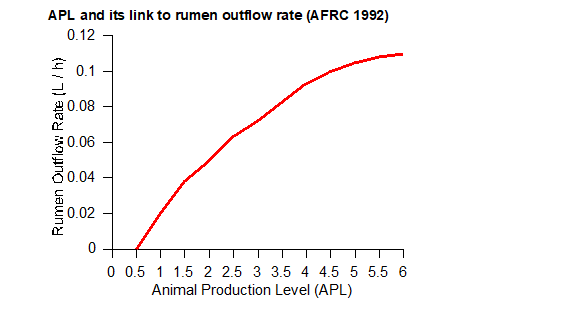
From this information it can be seen that an animal feeding at maintenance has a rumen outflow of 0.02 or 2% of its rumen contents per hour. this increases to about 10 % for ewes producing about 2.5 litres of milk from a ration containing about 50% concentrates.
The graph is not very well supported by masses of trial work at this time, but it does seem to be a reasonably good measurement on which to base predictions.
The RDP/UDP system assumed that the protein that was not degraded in the rumen, was digested in the small intestine, and the bit that wasn’t digested at all was a constant fraction of the protein.
This system began to show its limitations when farmers found that some of the raw materials that they were using, notably Maize Gluten and Dry Distillers Grains, often failed to live up to expectation. This was because the protein had been denatured by heat during manufacture and handling and, after reacting with sugars, became insoluble, and indigestible in the small intestine.
The indigestible protein can be measured by determining the amount of Nitrogen in the Acid Detergent Fibre (or ADF for short). this is referred to as the “Acid Detergent Insoluble Nitrogen” (or ADIN for short).
ADIN can be converted into “Acid Detergent Insoluble Protein” (ADIP) quite simply. Once this has been done it is easy to see how much of the protein expressed in a feedstuff analysis will be wasted.
A graphic example of this wastage factor can be found in rape seed meal where up to about 10% of the protein can be ADIP and therefore wasted.
The MP system is more accurate than the old RDP / UDP system because it automatically deducts this ADIP from the total UDP. The remaining fraction of UDP is known as Digestible Undegradable Protein (DUDP) or (DUP).
The other main element of doubt in the RDP/UDP system was that the RDP didn’t all degrade at a constant rate. We have already seen that the protein can be split up into A, B, and C fractions. The A fraction can vary from as low as 8% in soya to around 65% in grass silage. In the case of values as high as 65%, it is probable that the rumen microbes wont be able to cope with all of the ammonia that is being released.
Ammonia is a very important feed nutrient for the rumen microbes. They can use it to build more microbes, as long as they have access to an energy source.
Ammonia can be absorbed into the blood stream through the rumen wall very easily, so it is important to supply enough rapidly available energy in order to use the ammonia before it is wasted.
Sugar is probably the best source of energy under theses circumstances, but it should be fed at a constant rate in order to avoid acidosis.
The resultant improvement in microbe population will serve to help animal productivity.
The yield of microbes is in effect supplying the animal with extra protein in a usable form. This is known as Microbial Protein (MP).
Excess of ammonia, results in absorption into the blood stream as urea and is then excreted via the kidneys.
This element of waste can be very significant on high protein silages and on grass swards where animals graze soon after top dressing with nitrogen.
Good diets have to recognise this dilemma and provide the animal with better quality protein and/or, sugar to help the rumen microbes thrive in the potentially very rich nutrient source.
ERDP
There is just one last piece to the jigsaw of protein metabolism; “Effective Rumen Degradable Protein.”
ERDP is a measure of the amount of RDP that is actually available for microbial metabolism and growth. The old RDP/UDP system assumed that all of the RDP was available.
In fact, some of the ammonia released from the “A” fraction of the protein, is absorbed across the rumen wall into the blood stream as urea.
This Blood Urea can be measured as “Blood Urea Nitrogen” (BUN) and has a relationship with infertility in the female ruminant.
The BUN is normally filtered in the kidneys and excreted in the urine, but some is found in the milk of the lactating animal.
“Milk Urea Nitrogen” (MUN) is now commonly included on the milk data returned to the Dairy farmer. High MUN levels are a good indication of dietary imbalance and potential infertility problems. Low MUN levels are usually indicative of a dietary under supply of protein.
The “A” protein fraction is divided into two bits:-
QDP (Quickly Degraded Protein)
SDP (Slowly Degraded Protein)
The ERDP is calculated as 80% of the QDP plus the SDP.
If you have stuck with it so far, you have by now got a good grasp of the main elements of protein metabolism!
It is important to try and understand these abbreviations because they are in extensive use in virtually all of the definitive works on the subject. Once you have got to grips with the reasoning behind the definitions, will be much easier to make sense out of diet sheets and feed analyses.
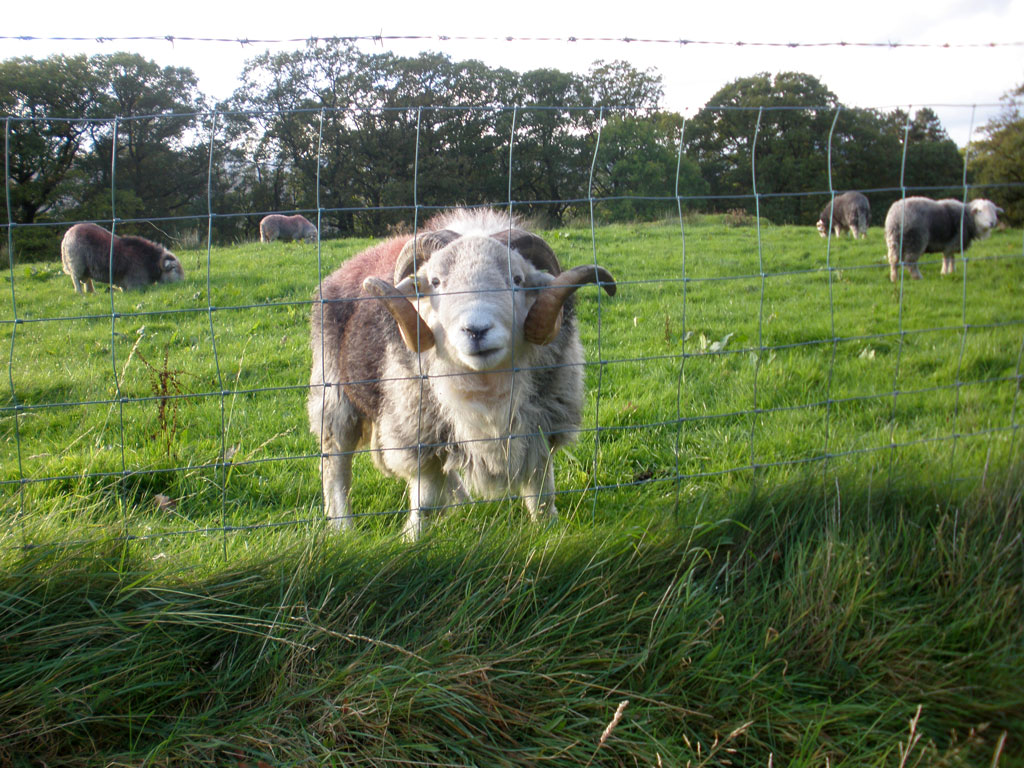
Protein Metabolism
The ruminant, like all animals, needs protein in the same way it needs energy, for Maintenance, Growth, Pregnancy, and Milk production.
As already mentioned, the FME is needed by the rumen microbes, to fix the ERDP in the form of microbial protein.
The FME content of the forage fraction of the diet, will have a direct influence over the amount and type of supplementation of energy and protein in the diet.
- Low FME forages will generally be low in ERDP and need heavy supplementation with high FME and high ERDP feedstuffs.
- High FME forages will require much less supplementation but tend to coincide with low NDF levels and, as a result may well need supplementing with fibre sources.
As a rule, Silages with high acid loading will need greater supplementation of both ERDP and FME from concentrates, (ie Soya bean meal and barley).
Microbial Protein Synthesis.
I love this bit of ruminant nutrition because it is so critical to getting good performance out of all ruminant livestock.
Anything we do to bring about an increase in the synthesis of microbes in the rumen, effectively increases the supply of nutrients to the animal. Live and dead bugs entering the abomasum and hind gut are effectively the main proportion of nutrient supply to the animal.
The basic concept of effective ruminant nutrition necessary to supply the genetic potential of highly bred modern ruminants; relies fundamentally on optimising the fermentation output capability of the animals rumen.
The temptation on the part of some nutritionists to overload the animal with bypass proteins and energies in the misguided belief that they are able to somehow meet the animals requirements more effectively; is frankly, an expensive way of trying to hide the inability they have to get the best performance out of the rumen.
The rules for optimising Microbial Crude Protein (MCP) output are in fact, really simple: –
If the supply of protein (Nitrogen) is too low, the MCP production is proportional to the supply of ERDP.
If the supply of energy is too low the MCP synthesis is proportional to the FME supply.
The yield of MCP per megajoule of FME is called “Y”.
“Y” is variable, and its value increases as production (APL) increases. (see table).
Figure 2
The relationship between APL and the yield of MCP per MJ of FME
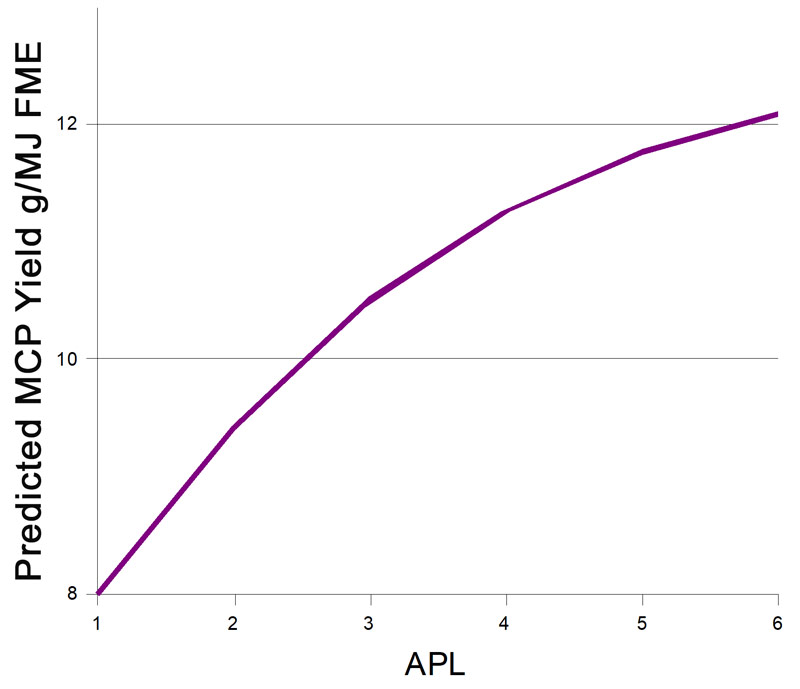
The Metabolisable Protein (MP) System.
The AFRC 1992 concluded that the MP system should be adopted as standard practise for the UK Industry.
The representation in figure 3 below (AT Chamberlain & J M Wilkinson (1996)) is a good representation summary of how the system elements are related to each other.
Notes: –
- Q D P is 80% available to microbes.
- Q D P + S D P = ERDP
- M C P production depends on availability of FME and the value of Y/
- Only 64% of M C P is absorbed
- U D P consists of indigestible waste (A D I P) and digestible Bypass protein (D U P)
- D U P varies according to A P L (the higher the A P L; the faster the rumen outflow rate, the greater the D U P fraction, and the smaller the ERDP fraction of any given feedstuff).
- 90% of D U P is absorbed
- Higher A P L = Higher F C E.
Metabolisable protein is eventually converted into Net Protein (NP). The efficiency of conversion varies according to the final use.
Figure 3
The metabolic pathways of protein utilisation
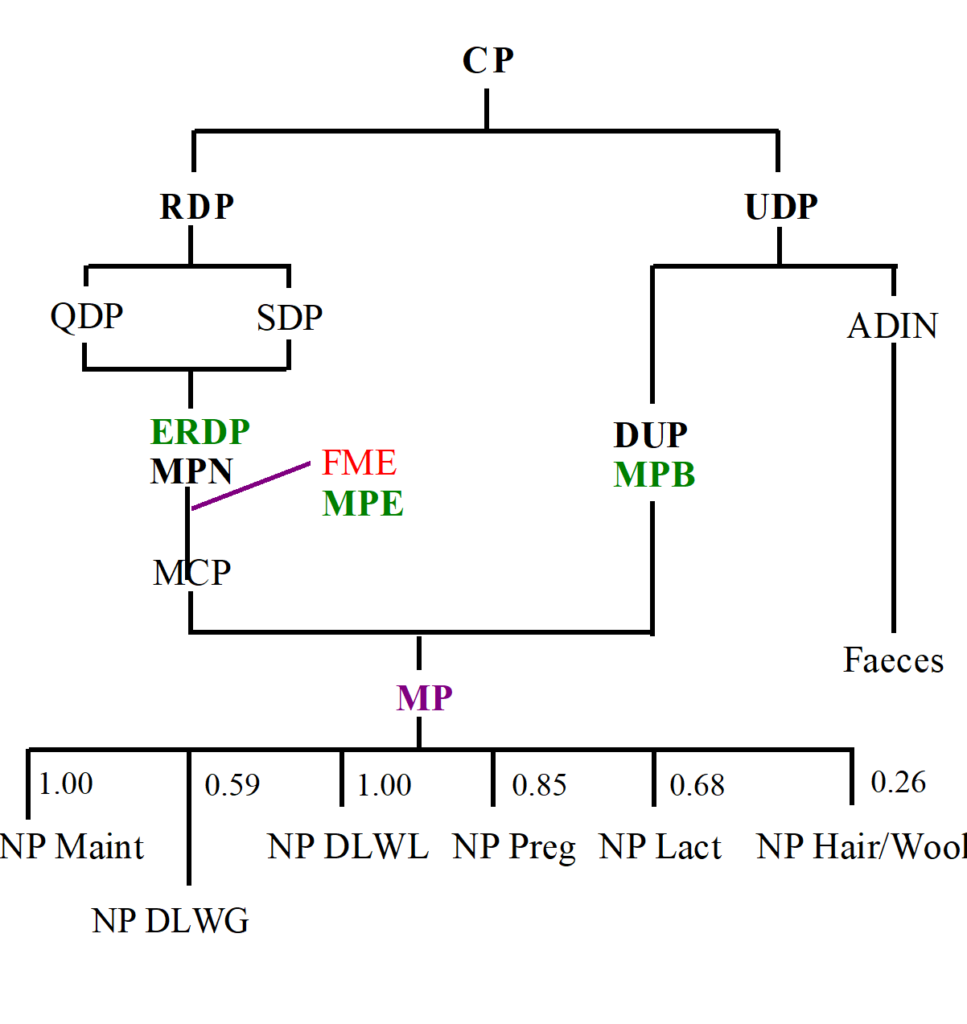
The figures shown for each end use represent the relative efficiency of conversion of each metabolic pathway.
The Metabolisable Protein system is a big improvement on the old Digestible Crude Protein (DCP) system but, it has its limitations.
- It is not very likely that the efficiency of uptake of Q D P will always be 80%.
- Nutritional data for many feeds is still incomplete.
- ADIN tests are very easily corrupted by nitrogen from the detergent, although laboratories have improved their techniques considerably.
- FME availability is likely to vary with rumen outflow rates, so high AP levels are likely to suffer from lower-than-expected FME levels. I have certainly found this to be true in very high yielding herds and fast-growing livestock. The assumption that FME evaluation is a fixed figure is probably wide of the mark in these situations.
These areas of concern mean that the practical use of the system is still one that is open to a deal of subjective interpretation (artistic license).
I personally favour the increase in use of sugar sources in many “complete” diets in order to get over the “normal” shortfall in FME. I also tend to lead feed energy and protein by up to 8% in high output situations.
It is difficult to imagine how we can progress much from this system of rationing when feedstuff variability and hence analytical confidence in feedstuff nutrient composition, means that any development in the accuracy of the rationing system will be diluted by the questionable nature of the data being used, so I think there is little point in chasing rainbows for the sake of the relatively small improvements likely to be achieved at the end of the line.
As a rule of thumb the ewe requires about 8 grams of RDP per megajoule of intake, this will generally convert to about 8 grams of Microbial protein
Protein Requirement Tables
Note:-1 Values do not vary in theory, but will in practise be approximate due to the effects of “Q”
values and APL.
Table 5 Protein (MP) requirements for weight change (g/day) (AFRC, 1992)
| Weight Change | MP |
| -1.00 Kg | – 131 |
| -0.75 Kg | – 98 |
| -0.50 Kg | – 66 |
| -0.25 Kg | – 33 |
| 0.00 Kg | 0 |
| 0.25 Kg | 61 |
| 0.50 Kg | 122 |
| 0.75 Kg | 183 |
| 1.00 Kg | 245 |
Balancing Protein Sources
Most feedstuffs contain some form of protein, the exception being the inorganic mineral sources.
As we have seen already, there are basically two types of protein, Effective Rumen Degradable Protein (ERDP), and Digestible rumen Undegradable Protein (DUDP)(or bypass protein). Both types of protein are very important.
ERDP
ERDP is commonly sourced from forages. Spring grass, for example can contain as much as 93% of its protein as ERDP! This percentage deteriorates as the season progresses, but even mid-summer grass is typically 85% ERDP.
The evolution of the rumen was designed to produce microbial protein by allowing the rumen bugs to multiply. This they do by using the ERDP from feedstuffs along with the fermentable energy from the same feeds.
It is important to make sure that diets contain enough ERDP to keep the rumen bugs reproducing at the optimum rate.
For sheep fed on grass this is not usually a problem, but sometimes dairy and beef animals fed on straw, wholecrop, or maize silage-based diets, may be deprived of ERDP from the basic forages.
In these cases, it is very important to introduce protein feeds rich in ERDP.
This is not always easy since many protein supplements also contain good levels of DUDP, and whilst the overall supply may be good it is vital that the rumen bugs get enough ERDP and that money is not wasted by feeding more DUDP than is required.
DUDP
DUDP is usually only needed as a supplement in very high output systems. Ewes at lambing and just after, will benefit considerably from inclusions of up to 15% of their protein as DUDP.
Lamb and calf creeps should also include DUDP at around 20%.
High yielding dairy cows may need as much as 30% of their dietary protein as DUDP.
The DUDP fraction of the protein is coincidentally the portion that tends to contain the richest sources of essential, and im some cases, performance limiting amino acids. Diets may well be balance for ERDP and DUDP but sometimes they are limited in performance by lack of amino acids like lysine or methionine.
Amino acid balancing is a growing part of ruminant nutrition, especially in pedigree, high output diet situations. For sheep, the amino acid balances have not really been considered to any great degree but it will be true that with the highly bred pedigree sheep the issue of limiting essential amino acids is much more likely to have an affect on rates of daily liveweight gain.
For now we don’t really see much of a challenge but possibly in the future supplementing say milking sheep with some extra methionine would be a valid consideration!
Rationing Tips
- Ewes only require DUDP supplementation if they are carrying twins or triplets near to lambing and just after. The addition of 50 grams of high-quality fish meal is tremendously effective. Trials at the Rowett Research Institute in the mid 1980’s showed a marked improvement in colostrum quality and milk yield from ewes that were fed on fish meal.
- Dry cow rations benefit from the addition of around 500 to 600 grams of protected soya meal from 3 weeks before calving. This is believed to assist the animal to mobilise some of its back fat prior to calving and improve colostrum yield and quality. It has also been shown that animals come into milk production much faster and are generally easier to get back in calf. The effect is similar to the supplementation of fish meal in sheep diets.
- Fish meal is high in calcium and is therefore not recommended for dry cow diets.
- Animals fed on low protein forages may be supplemented with Non-Protein Nitrogen from feed grade Urea. This source of nitrogen can be converted by the rumen bugs into microbial protein, in the presence of water and a suitable energy source, like molasses. It is now possible to buy ready mixed molassed urea supplements. These supplements are a safe option because they contain a regulated slow-release formula that prevents a rapid buildup of ammonia in the rumen.
- Feeding urea on its own has to be done very carefully indeed since it is very easy to induce serious health problems arising from excessive absorption of ammonia into the blood stream. Sheep have died from inclusions of as little as 8.5 g per day and yet others can thrive on as much as 50 g per day. Unfortunately, it is not possible to prescribe accurate limits for any animal.
- The little table below shows the desired ratios of ERDP to DUP in various ruminant diet situations expressed as percentages.
| ERDP | DUP | |
| Ewe 6 weeks to lambing | 90% | 10% |
| Ewe 2 weeks to lambing | 85% | 15% |
| Pedigree lowland ewe 2 weeks to lambing (twins) | 80% | 20% |
| Ewe 2 weeks after lambing | 85% | 15% |
| Ewe at weaning | 95% | 5% |
| High yield dairy cow (40 litres) | 75% | 25% |
| Mid yield dairy cow (25 litres) | 80% | 20% |
| Late yield dairy cow (12 litres) | 85% | 15% |
| Dry cow 3 weeks to calving | 80% | 20% |
| Lamb or Calf 5 weeks of age | 80% | 20% |
| Heifer 15 months | 85% | 15% |
| Intensive bull beef 8 months | 85% | 15% |
- Like most raw materials, buying proteins should be considered very carefully. The following points should be considered.:-
- How much, and what quality of protein exists in the forages that need balancing? Have you had the forages analyzed?
- Is the price of bought in protein supplements representative of good value for money? What is the cost per tonne of dry matter, of any potential supplement compared to other feeds? This helps to put the price of succulents like brewers grains and distillers draft into perspective.
- What is the protein quality like? DCP, ERDP, DUP, ……..
- Is there a particular benefit from essential amino acids? Lysine, Methionine, Leucine….
- How will the bought in feed need to be stored and fed?
- Is the feedstuff traceable back to source? Modern feed systems should be able to trace all feedstuffs back to origin. This is a growing requirement of UK buyers and is true of all bought in feedstuffs not just proteins.
